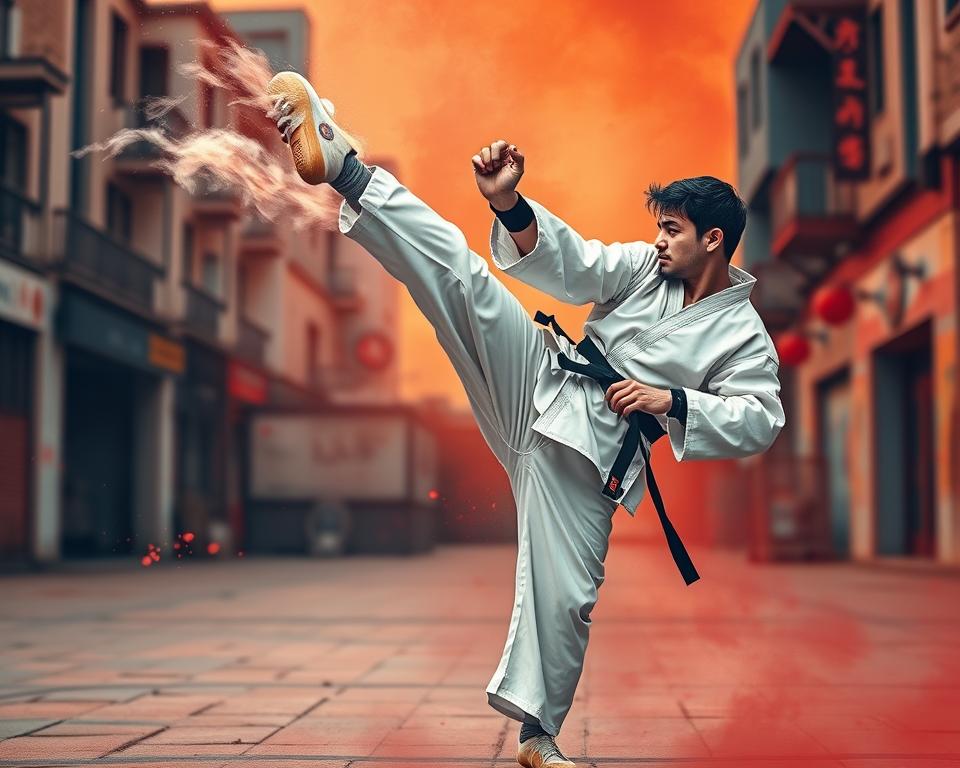Taekwondo, a dynamic Korean martial art, has won the hearts of people all over the world. It’s known for its exciting sparring, where fighters show off their skills in speed, agility, and strategy. This guide will cover the key techniques and tips you need to do well in taekwondo sparring. It’s perfect for both beginners and seasoned martial artists.
Read interesting things at : apportfolioasia
Key Takeaways
- Explore the fundamental techniques and strategies for successful taekwondo sparring
- Understand the rules, regulations, and scoring system to excel in competition
- Develop effective footwork, striking, and kicking techniques to dominate the sparring arena
- Implement defensive strategies and evasive maneuvers to counter your opponent’s attacks
- Enhance your mental preparation and cultivate a winning mindset for taekwondo sparring
Understanding Taekwondo Sparring
Taekwondo sparring is the exciting core of this martial art. It mixes fast strikes, strong kicks, and smart footwork. At its heart, it’s a blend of discipline, precision, and top-notch athleticism.
The Essence of Taekwondo Sparring
Taekwondo sparring goes beyond just fighting. It shows the deep philosophy and spirit of this ancient Korean martial art. Practitioners need to balance agility, strength, and mental strength in their matches.
The Rules and Regulations
There are strict rules for taekwondo sparring to keep things safe and fair. These rules cover legal moves, protective gear, and how points are scored. Knowing and following these rules is key to doing well in sparring.
“Taekwondo sparring is not just a test of physical prowess; it’s an elegant dance of strategy, discipline, and respect.”
Learning about taekwondo sparring’s essence and rules helps practitioners appreciate the art more. It also improves their skills and confidence.
Taekwondo Sparring Techniques
In the world of taekwondo sparring, striking and kicking are key. These skills show the sport’s discipline and artistry. They also help athletes do well in competitions and training.
Striking Techniques
Learning to strike is vital for taekwondo athletes. They need to know how to throw quick jabs and powerful hooks. They must also block strikes well and dodge incoming punches.
Slipping and weaving help fighters avoid punches. This lets them launch their own attacks.
Kicking Techniques
Kicking is what makes taekwondo stand out. Athletes need to know many kicks, like the front kick and roundhouse kick. Kicks like the spinning heel kick and jumping side kick are also important.
These kicks need flexibility, balance, and power. They’re both exciting to watch and hard to do in a fight.
By learning both striking and kicking, taekwondo athletes get a full set of moves for sparring. This makes them strong in competitions and real-life self-defense situations.
Footwork and Movement
In the world of taekwondo sparring, footwork and movement are key to winning. Learning how to move smartly can boost your skills in martial arts competition and combat training. By improving your movement, you can stay balanced, control the space, and set up strong attacks and defenses.
Doing footwork drills is a must for better movement skills. These exercises improve your speed, quickness, and balance, which are vital for sparring. Practicing these drills often will build the muscle memory and fast reflexes you need to react quickly to your opponent.
- Lateral Steps: Practice quick side-to-side movements, shifting your weight and maintaining a stable stance.
- Forward and Backward Steps: Develop the ability to smoothly transition between advancing and retreating, controlling the distance.
- Pivot Turns: Master the art of pivoting on your lead foot, allowing you to change direction and set up counterattacks.
- Feinting and Fakes: Incorporate deceptive footwork to create openings and catch your opponent off guard.
Mastering these footwork drills will make you agile and strategic in taekwondo sparring. Add these moves to your striking and kicking skills, and you’ll be ready to compete in the martial arts competition arena.
| Footwork Technique | Description | Benefits |
|---|---|---|
| Lateral Steps | Quick side-to-side movements, shifting weight and maintaining a stable stance. | Improved agility, balance, and ability to control distance. |
| Forward and Backward Steps | Smooth transition between advancing and retreating, controlling the distance. | Enhanced positional control and ability to set up attacks and counterattacks. |
| Pivot Turns | Mastering the art of pivoting on the lead foot to change direction and set up counterattacks. | Increased maneuverability and the element of surprise in combat training. |
| Feinting and Fakes | Incorporating deceptive footwork to create openings and catch opponents off guard. | Improved ability to set up and execute successful attacks in martial arts competition. |
Footwork and movement are crucial for success in taekwondo sparring. Embrace the challenge of mastering these techniques, and you’ll be ready for success in combat training and more.
Defensive Strategies
In the world of taekwondo sparring, having a strong defense is key. Learning to block and dodge is vital. It helps protect you and opens doors for counterattacks.
Blocking Techniques
Blocking is a key part of defense in taekwondo. It stops your opponent’s attacks and lets you strike back. Focus on hand, arm, and footwork blocks to improve your defense.
Evasive Maneuvers
Evasive moves are also crucial in taekwondo sparring. Good footwork and timing help you dodge attacks and set up your own strikes. Try different moves like side-steps and pivots to get better at dodging.
Using blocks and dodges together makes a strong defense. This strategy helps you protect yourself and take control of the fight. These skills are great for martial arts and self-defense too.
Conditioning for Taekwondo Sparring
Being great at taekwondo sparring is more than just knowing the moves. You need to be physically fit. You need strength, endurance, and flexibility for combat training and martial arts competitions.
Start with strength training to build a solid base. Work on your core, legs, and upper body to boost your power and speed. Then, add cardio like high-intensity intervals to build stamina for long sparring matches.
Flexibility is key too. It helps you move better and avoid getting hurt. Stretch often, focusing on your hips, hamstrings, and ankles. This will help your kicking and keep you moving freely in the ring.
| Physical Attribute | Recommended Training |
|---|---|
| Strength |
|
| Endurance |
|
| Flexibility |
|
Using these training methods, taekwondo practitioners can get the physical skills needed to do well in combat and competitions.
Developing a Winning Mindset
Being good at martial arts competition and self-defense tactics isn’t just about being strong physically. You also need a strong mind. Having a winning mindset is key for doing well in taekwondo sparring. This part will talk about how to get ready mentally and the importance of positive self-talk to help you spar with confidence and determination.
Mental Preparation
Before you start sparring, getting your mind ready is crucial. Imagine yourself doing your moves perfectly, guessing what your opponent will do, and winning. This helps improve your focus, lowers stress, and makes you feel calm and in control.
Positive Self-Talk
What you tell yourself matters a lot to how you do. Start using positive self-talk, swap negative thoughts for positive ones about your skills and willpower. Think about your training, how hard you’ve worked, and how you’ve gotten past tough times. This keeps you feeling confident and calm when you spar.
“Believe in yourself and all that you are. Know that there is something inside you that is greater than any obstacle.” – Christian D. Larson
Mastering the mental side of taekwondo sparring lets you reach your full potential. With regular practice and a positive outlook, you’ll be on your way to doing well in martial arts competition and improving your self-defense tactics.

Protective Gear and Safety
Your safety is key in taekwondo sparring. Using the right protective gear is vital to avoid injuries. This section talks about the must-have equipment like headgear, mouthguards, and padding for your sparring outfit.
Wearing the right protective gear is a must for safety and a rule in martial arts competitions and self-defense training. Good gear lets you spar safely and with confidence.
- Headgear: Protects your head and face from direct strikes, reducing the risk of concussions and other head injuries.
- Mouthguards: Safeguards your teeth and gums, preventing dental injuries during intense sparring.
- Chest protectors: Shields your torso, absorbing the impact of kicks and punches to minimize internal trauma.
- Groin guards: Safeguards your most sensitive areas, ensuring a comfortable and secure sparring experience.
- Shin and forearm guards: Protects your lower legs and arms, preventing bruises and abrasions from blocks and strikes.
Following safety protocols is key for your health and the success of your sparring. Using protective gear lets you improve your taekwondo skills without worrying about getting hurt.
| Protective Gear | Purpose | Recommended Features |
|---|---|---|
| Headgear | Protects the head and face | Shock-absorbing padding, full facial coverage, secure fit |
| Mouthguard | Safeguards teeth and gums | Custom-fitted, durable material, comfortable fit |
| Chest Protector | Shields the torso | Flexible, shock-absorbing design, adjustable straps |
| Groin Guard | Protects the genital area | Rigid shell, secure fit, comfortable materials |
| Shin and Forearm Guards | Safeguards lower legs and arms | Durable, lightweight construction, adjustable straps |
“Protective gear is not just a recommendation, but a necessity for safe and effective taekwondo sparring. Investing in the right equipment can give you the confidence to push your limits without compromising your well-being.”
Competition Strategies
Entering martial arts competitions is thrilling, but you need a good plan to do well. Focus on ring discipline and the point scoring system to improve your chances.
Ring Discipline
Ring discipline is key in taekwondo matches. Listen to the referee’s commands like “Cha-ryeot” (attention), “Kyeong-rye” (bow), and “Sijak” (start). Stay calm and show respect to your opponent and the officials. This will help you earn points and set a good mood for the fight.
Point Scoring System
The taekwondo scoring system rewards precise and smart moves. You get points for hitting or kicking certain areas, especially the head. Knowing how to score and aiming for these spots can help you win.
Focus on ring discipline and the point scoring system for a strong competition strategy. A mix of skill, strategy, and mental strength is crucial for doing well in martial arts competitions.
Taekwondo Sparring for Self-Defense
Taekwondo sparring is not just for competition. It’s also great for self-defense. The skills you learn can help you protect yourself in real life.
The training focuses on quick moves, strong kicks, and fast strikes. These skills can help you stop or defend against an attacker. Practicing these moves in sparring builds your confidence and muscle memory for stressful situations.
Sparring also improves your mind. It teaches you to stay calm, think clearly, and avoid fights. This can help you solve problems without violence.
When facing danger, like a mugging or an attack, taekwondo skills can make a big difference. They teach you how to defend yourself effectively. This way, you can stay safe and feel confident in protecting yourself.
- Taekwondo’s focus on footwork, kicks, and quick strikes gives you the skills for self-defense.
- Sparring builds your confidence, muscle memory, and decision-making skills for real threats.
- It also teaches mental discipline, awareness, and staying calm under pressure, which are key for self-defense.
- Using taekwondo in real life can boost your safety and confidence in defending yourself.

“Taekwondo sparring is not just about competition, but about developing the skills and mindset to protect oneself when it truly matters.”
Through taekwondo sparring, you can learn versatile self-defense tactics. This makes taekwondo a strong tool for staying safe and secure.
Referee Commands and Signals
In the world of martial arts competitions, knowing the referee’s commands is key. It keeps the match running smoothly. As a taekwondo practitioner, learning these referee commands helps you react fast and stay in the game.
“Begin” means the match starts. You need to be ready to fight with skill and control. “Stop” means the action pauses so the referee can look at the situation or fix problems.
Hand signals from the referee are also important. A raised fist might mean a point for you, while an open palm could be a warning. Watching these signals helps you plan your next move.
Learning referee commands and signals is more than just following rules. It makes you a key part of the martial arts competition. This knowledge boosts your awareness, helps you make smart choices, and improves your performance in the ring discipline.
| Referee Command | Meaning |
|---|---|
| Begin | Start the match |
| Stop | Temporarily pause the match |
| Break | Separate the competitors |
| Point | Award a point to a competitor |
| Penalty | Issue a warning or penalty to a competitor |
Knowing these referee commands and signals prepares you for martial arts competitions. It helps you shine in the ring discipline.
Taekwondo Sparring Drills
Mastering taekwondo sparring takes more than just skill. It also needs regular practice and hard work. We’ll look at drills for footwork and combinations to improve your skills. These drills are great for martial arts competitions or combat training.
Footwork Drills
Good footwork is key in taekwondo sparring. These drills help you move fast, change direction, and stay balanced. Important drills include:
- Forward and backward steps
- Side-to-side shuffles
- Pivot turns
- Lateral movements
- Jumping and hopping exercises
Doing these drills often makes you quicker and more agile. This lets you dodge attacks, set up counterattacks, and control the fight.
Combination Drills
Taekwondo is all about quick and powerful moves. Combination drills help you link strikes, kicks, and defenses smoothly. Some top drills are:
- Jab-cross-roundhouse kick
- Front kick-side kick-back kick
- Spinning hook kick-axe kick-knee strike
- Defensive block-counter punch-spinning back kick
Mastering these drills lets you do complex moves with precision. This gives you an edge in martial arts or combat training.
“The key to success in taekwondo sparring is not just in the individual techniques, but in how you link them together seamlessly. Combination drills are the foundation for building that fluidity and timing.”
Practicing footwork and combination drills regularly boosts your skills for taekwondo sparring. This is true whether you’re in martial arts tournaments or improving your self-defense skills.
Taekwondo Sparring: Tips for Success
Mastering taekwondo sparring is about more than just moves. It’s about strategy, mental strength, and skill. As you step up your game in martial arts, think about these tips to do better.
- Develop a Solid Foundation: Know the basics of taekwondo like striking, kicking, and moving. Practice often to get these skills sharp and confident for sparring.
- Enhance Your Defensive Skills: Being good at defending is key in sparring. Work on blocking and dodging to beat your opponent and open up chances to attack.
- Cultivate a Winning Mindset: Your mind matters a lot in sparring. Talk positively to yourself, imagine winning, and stay focused and determined.
- Prioritize Fitness and Conditioning: Sparring needs stamina and power. Do exercises like plyometrics and core workouts to boost your fitness and performance.
- Understand the Rules and Regulations: Know the sparring rules and how points are scored. This helps you make smart moves, score well, and avoid penalties.
Follow these tips to improve your taekwondo sparring skills. They’ll help you do well in competitions or defend yourself in real life.
| Technique | Description | Application |
|---|---|---|
| Roundhouse Kick | A powerful, circular kick delivered with the instep or ball of the foot. | Effective for scoring points and creating openings in the opponent’s defense. |
| Defensive Blocks | Techniques used to intercept and deflect incoming strikes and kicks. | Critical for protecting oneself and setting up counterattacks. |
| Footwork Patterns | Choreographed movements and stance transitions to navigate the sparring area. | Enhances mobility, balance, and the ability to seize tactical advantages. |
Practice regularly, have a broad skill set, and stay positive to excel in taekwondo sparring. This approach is key for success in martial arts, training for combat, or self-defense.
“In the end, it’s not the years in your life that count. It’s the life in your years.” – Abraham Lincoln
Conclusion
As we wrap up this guide on taekwondo sparring, remember the value of always learning and practicing hard. This martial art is a journey. By seeing it this way, you’ll reach your best in this exciting discipline.
We’ve looked at the main ideas and strategies you need for taekwondo sparring. You now know the basics and how to improve your combat training skills. This gives you a complete view of what it takes to do well in this martial art.
Success in taekwondo sparring comes from practicing regularly, staying strong in your mind, and being open to change and growth. Using what you’ve learned here, you’re on your way to being great at self-defense tactics. This will help you in both competitions and everyday life.


